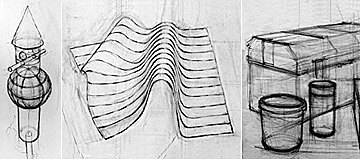

INTRODUCTION TO PERCEPTUAL DRAWING

Students will be working from both life and imagination as they work to develop the perceptual, conceptual and mechanical skills necessary to translate three dimensional form and space onto a two dimensional surface. We will work almost exclusively with dry, black media on paper.
Sequence of Topics
LINE
Developing sensitivity to the expressive potential of this most basic of drawing elements will be a major concern throughout the semester. We will experience the visual excitement, emotive potential, exhilarating freedom and infinite variation that can be produced with line.
ANALYTICAL GESTURE
An important tool for highlighting our awareness of our perceptions and at the same time developing a control over transferring those perceptions to a two dimensional surface is analytical gesture.
This technique emphasizes a quick, all encompassing overview of the objects and space under consideration. The goal here is to teach our hand to duplicate the movement of our rapidly moving eyes in order to define shape, placement, scale, internal proportions, weight and movement. The emphasis is not on drawing objects but rather on collecting information about relationships between and within objects. Spontaneity, energy, and line sensitivity play a critical part in the experience.
POSITIVE/NEGATIVE SHAPE AND CONTOUR
Increasing our understanding of spatial relationships require the ability to see the “shape of where things are” and the “shape of where things aren’t”. Admittedly, this terminology is cumbersome but the visual experience we will share will gradually clarify this wonderful dualism. The sensitivity to Positive/Negative relationship is critical to the perceptual skills we are seeking to develop. It is also a fundamental element in the understanding of effective pictorial composition on which we will concentrate later in the semester.
Our concern for shape naturally leads us to a concern for the delicate variations we find when looking at the outside edges, the contour, of form. Through a series of exercises we will work to improve our observation of detail and individualized characteristics in the objects under consideration.
PROPORTION
The study of proportion (size relationships) will help us overcome one of the most common errors in drawing from life - confusing what we know (concepts) with what we see (percepts). In order to overcome these preconceptions we will be introduced to some mechanical measuring techniques that are based on the horizontal and vertical axes which reinforce the essential character of the surface upon which we draw.
In addition, we will review the spiritual tradition that pursues perfection through ideal proportions in what is known as sacred geometry. Also, in a tangentially related area, we will consider the evolving standards of beauty as they relate to human proportions.
VOLUMETRIC EXPRESSION(cross contour, chiaroscuro):
Throughout the history of art there has been a fascination with hand made images that look “real”. We will focus our attention on a few of the most effective techniques for creating such strong illusions of three-dimensionality that the tradition is called “trompe l'oeil” or “fool the eye”. We will concentrate on cross contour and chiaroscuro while investigating the role exaggeration plays in creating convincing illusion.
LINEAR PERSPECTIVE
Although we have already been transferring 3-D information to our paper in nearly all the previous exercises and are rapidly gaining control of the process, our accuracy will increase as we begin to more fully understand the theoretical foundations and variety of approaches used in communicating spatial information. We will begin with an introduction to the history, underlying philosophy, technical theory, and intuitive practice of one, two, and three point perspective. In this process we will come away with an in depth understanding of how drawings make spatial meaning. This section stresses both the expressive strengths and inherent limitations of linear perspective by distinguishing the characteristics of the “visual field” of linear perspective from those of the “visual world” of our perceptual experience.
GEOMETRIC SIMPLIFICATION
Drawing from life demands heavy emphasis on perceptual information gathering and that is reflected in the majority of the experiences we have had in class so far. With the introduction of linear perspective, though, we have actually shifted direction rather markedly and have begun to emphasize the value of a clear, conceptual framework for grater understanding in our translations of 3-dimensional experience to paper. Geometric simplification is a system where we attempt to reduce our perceptions to the most fundamental geometric forms by superimposing the rational order of perspective on our intuitive perceptions. This process will substantially increases our ability to clarify meaning in our drawings.
